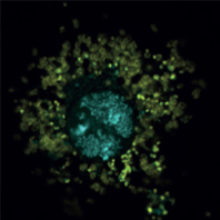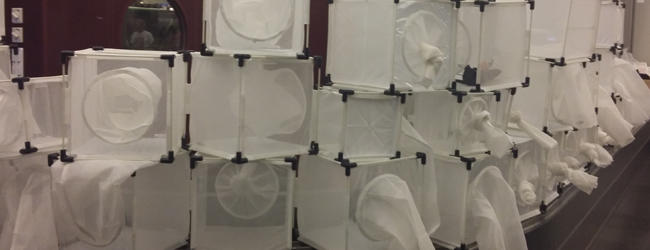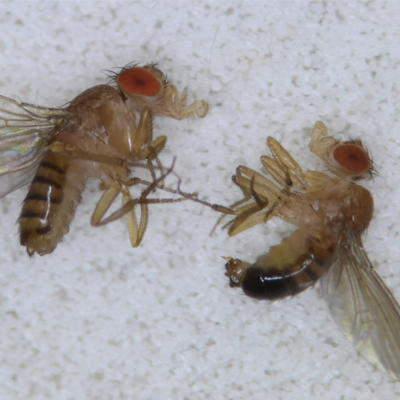Wolbachia – basic science and applications of an antiviral bacterium
Issue: Arboviruses and their Vectors
06 August 2019 article

Mosquitoes cause a lot of human suffering – every year over one million people worldwide die from mosquito-borne diseases. Wolbachia, an intracellular, insect-associated bacterium, can protect mosquitoes from viruses and reduce their numbers. If mosquitoes are either virus-free or absent, they cannot infect humans. Therefore, Wolbachia holds a promise for the successful control of many mosquito-borne diseases.
As the applied use of Wolbachia and potential public health benefits have drawn a lot of media attention and research funding, the basic research which has led to these developments has often been forgotten. Wolbachia-conferred antiviral protection was initially discovered in the fruit flies, Drosophila melanogaster. Fruit flies were also the donors of an antiviral Wolbachia for the Aedes aegypti mosquito, the main dengue, Zika and chikungunya vector. The research on Wolbachia in and from Drosophila both founded and continues to inform the field initiatives. Applied Wolbachia research, aimed at using it to fight diseases, and the basic research, aimed at understanding how Wolbachia works, are not two separate worlds, but rather complementary programmes.
What is Wolbachia and how can it help?
Wolbachia is the most prevalent intracellular bacterium on the planet. It naturally infects most insect species, and it is transmitted from the mother to the offspring inside insect eggs. This microbe can spread through a population of insects through ‘cytoplasmic incompatibility’, where females without the bacterium are effectively sterilised by mating with males harbouring it. Wolbachia-infected females (that are immune to this sterilisation) can then produce more offspring every generation, and this is how Wolbachia increases in frequency. The likely mechanism of this phenomenon, relying on the Wolbachia-produced toxin and antitoxin, has been recently described based on studies in Drosophila.

In addition to cytoplasmic incompatibility, Wolbachia infection often alters the susceptibility of insects to viruses. Commonly, insects carrying Wolbachia are less sensitive to attack by a particular group of viruses. This group includes dengue, Zika, West Nile and chikungunya viruses causing human vector-borne diseases. However, how Wolbachia produces this effect is poorly understood. To understand the mechanism of Wolbachia-induced pathogen blocking we need to develop new research tools and techniques. Meanwhile, approaches using Wolbachia in the wild are in trials globally, with the aim to reduce the burden of arboviruses in humans.
Killing mosquitoes with Wolbachia
Wolbachia-induced mating incompatibilities can be used to reduce the number of certain insects or even eradicate them completely. In this case, fewer-to-no mosquitoes means less-to-no disease. In practice, this strategy involves artificial rearing (in the laboratory insectaries and mosquito factories) and releasing Wolbachia-infected mosquito males, which mate with wild females, that then produce no offspring. If a sufficient number of incompatible males are released, the population of the disease vector may even collapse. This strategy was first applied in 1967 to eradicate the vector of filariasis in one village in Myanmar. The approach was re-established forty years later to target other diseases and mosquito species in French Polynesia and the USA.
Unlike pesticide alternatives, Wolbachia release does not damage non-target insects and leaves no environmental chemical residue that may harm human health. If mosquito populations cannot be eradicated, repeated releases, often year by year, can be performed to suppress populations. One challenge this strategy faces though is separating mosquito males from females on a large scale. This process is error- prone, and if enough Wolbachia- infected females are released, then the population suppression strategy will cease to work (as infected females can produce offspring with infected males).
Making mosquitoes virus-free
As with many other breakthrough discoveries, the discovery of Wolbachia-conferred antiviral protection was first made in the fruit fly. After challenge with pathogenic viruses, Wolbachia-infected flies had lower viral load and survived better than their Wolbachia-free counterparts. Drosophila and mosquitoes are closely related, so shortly after the experiments from flies were repeated in Aedes aegypti, the vector of dengue, Zika, West Nile and chikungunya viruses. And with success: Wolbachia could reduce both viral load and transmission in mosquitoes. Pilot releases of Wolbachia-infected virus-resistant Aedes aegypti have now been undertaken in Australia, Indonesia, Vietnam, India, Sri Lanka, Brazil, Colombia, Fiji, Vanuatu, Kiribati and Mexico. Early data are encouraging, and the upcoming years will establish the success of these field trials.

And there is a twist to this story. As Aedes aegypti mosquitoes do not harbour natural Wolbachia infections, Wolbachia from Drosophila has been introduced there artificially in the laboratory, with the fruit fly as the first Wolbachia donor in this interspecies Wolbachia transplant. Although many other insects have also served as a source of Wolbachia for Aedes aegypti, Wolbachia from Drosophila melanogaster is dominating the field releases lead by The World Mosquito Program.
Basic and applied Wolbachia research – two sides of the same coin
Basic research on the fruit fly, Drosophila melanogaster, has initiated the efforts to eradicate diseases by making mosquitoes disease-proof. Now, studies on Wolbachia-induced effects could improve current or initiate novel antiviral interventions.
Drosophila is a great model to study mechanisms of pathogen blocking by Wolbachia. Flies, in contrast to mosquitoes, can be reared easily (for example, they can complete their life cycle in a single small vial, and they do not need to eat blood). They also do not try to bite you all the time! Further, as a natural Wolbachia host, Drosophila may be a good model to study the antiviral protection by itself, without all the additional effects observed in Aedes due to the recent Wolbachia transplantation.
Although the general mechanism of Wolbachia-conferred protection remains unknown, studying Wolbachia from Drosophila has taught us a lot about its applications in vector-borne disease control.
- Not all Wolbachia strains are the same. Strains differ in the strength of the antiviral protection they induce, in their sensitivity to heat stress, and in their ability to spread through populations. Choosing the best strain for the field applications is important, as once any Wolbachia gets established in the population, mating incompatibilities will prevent its easy replacement with another Wolbachia strain.
- The more Wolbachia in an insect, the stronger the antiviral protection. Yet, this leads to a higher burden on the insect – more ‘mouths to feed’. The choice of optimal Wolbachia strain for field interventions has to include the cost-to-benefit ratio.
- Antiviral effects are complex. How much virus blocking occurs depends not only on Wolbachia but also on the host, the virus and the environmental conditions. All of these can change over time. Without knowing exactly how protection occurs, it is hard to predict how efficiently Basic research on the mechanisms of Wolbachia-induced effects, especially the mechanism of pathogen blocking, could improve current or initiate novel strategies aimed at eliminating arboviruses. The knowledge gained could be used to the benefit of humans extending far beyond the control of vectors and vector-borne diseases.
Further reading
Chrostek E, Marialava MSP, Esteves SS, Weinert LA, Martinez J. Wolbachia variants induce differential protection to viruses in Drosophila melanogaster: a phenotypic and phylogenomic analysis. PLoS Genet 2013;9:e1003896.
Lindsey ARI, Bhattacharya T, Newton ILG, Hardy RW. Conflict in the intracellular lives of endosymbionts and viruses: a mechanistic look at Wolbachia-mediated pathogen-blocking. Viruses 2018; 10:141.
Teixeira L, Ferreira A, Ashburner M. The bacterial symbiont Wolbachia induces resistance to RNA viral infections in Drosophila melanogaster. PLoS Biol 2008;6:e1000002.
The MosquitoMate Program USA. https://mosquitomate.com/?v=3.0 [accessed 3 June 2019].
The World Mosquito Program. https://www.worldmosquitoprogram.org [accessed 3 June 2019].

Ewa Chrostek
FEBS Fellow (until 2019) and Marie Skłodowska-Curie Fellow (from 2019), Institute of Integrative Biology Biosciences Building, University of Liverpool, Crown Street, Liverpool L69 7ZB, UK
Twitter: @EwaChrostek
LinkedIn: ewa-chrostek-0474971a
I gained my master’s degree in Biotechnology (Jagiellonian University, Krakow, Poland) and PhD in Host–Microbe Interactions (Instituto Gulbenkian de Ciencia, Oeiras, Portugal). Subsequently, I was an EMBO Fellow at the Max Planck Institute for Infection Biology (Berlin, Germany). Since March 2018, I have been working at the University of Liverpool, UK.
What inspired you to become a microbiologist?
I am a child of a microbiologist and a biochemist. We had a lot of biology textbooks at home and I loved to visit labs, with all of the interesting machines, colourful science posters, and nice people. Beyond any doubt, my parents inspired me to become a scientist.
How do you see this field changing in the future?
I hope more work will be done on the genomic dark matter – genes and proteins we know nothing about. Many of these are essential to keep cells alive. Others may have very specific functions in processes we cannot predict or imagine. I think a lot of fascinating biology is still out of our reach, and we need systematic approaches to address this at a large scale.
Thumbnail: Insect cells infected with Wolbachia. Fluorescent microscopy image showing Wolbachia bacteria (yellow) surrounding Drosophila cell nuclei (blue). Ewa Chrostek.
Image 1: Mosquito rearing cages. Ewa Chrostek.
Image 2: Drosophila melanogaster, the fruit flies. Krzysztof Kuś.


